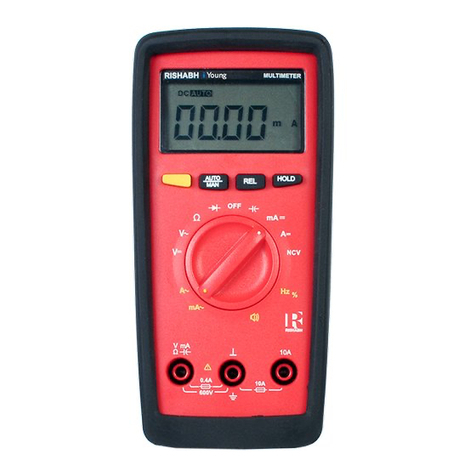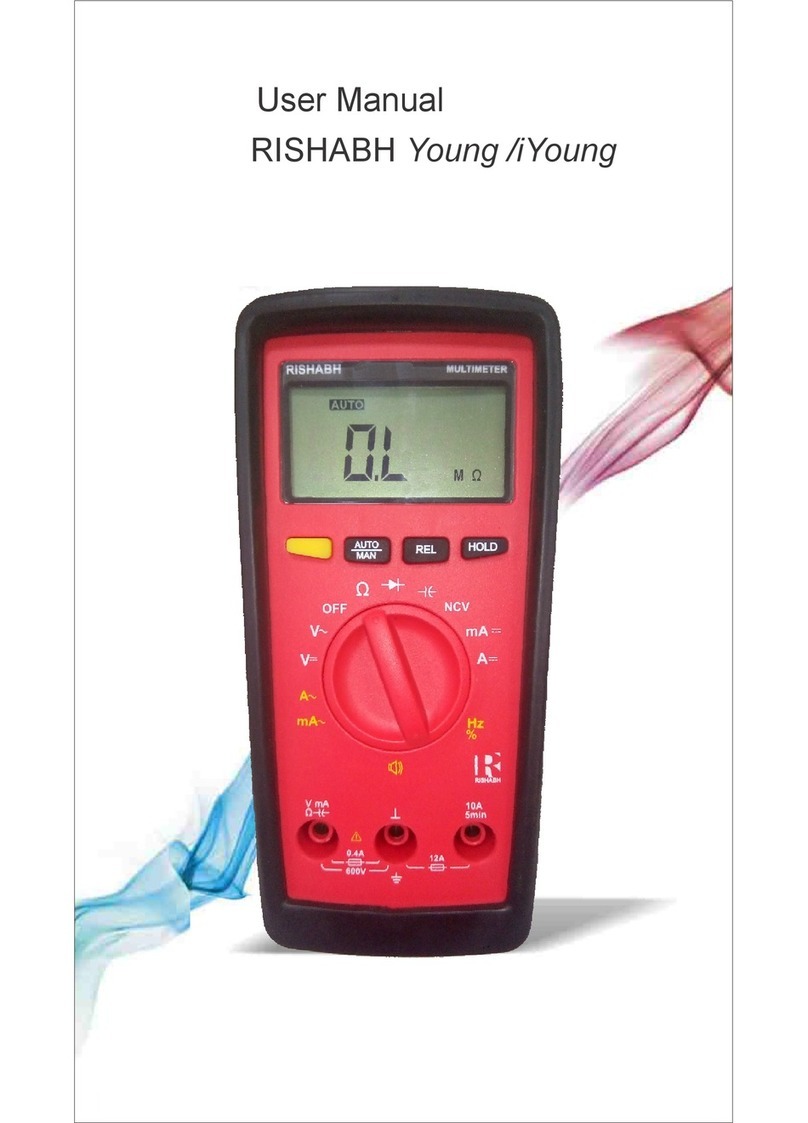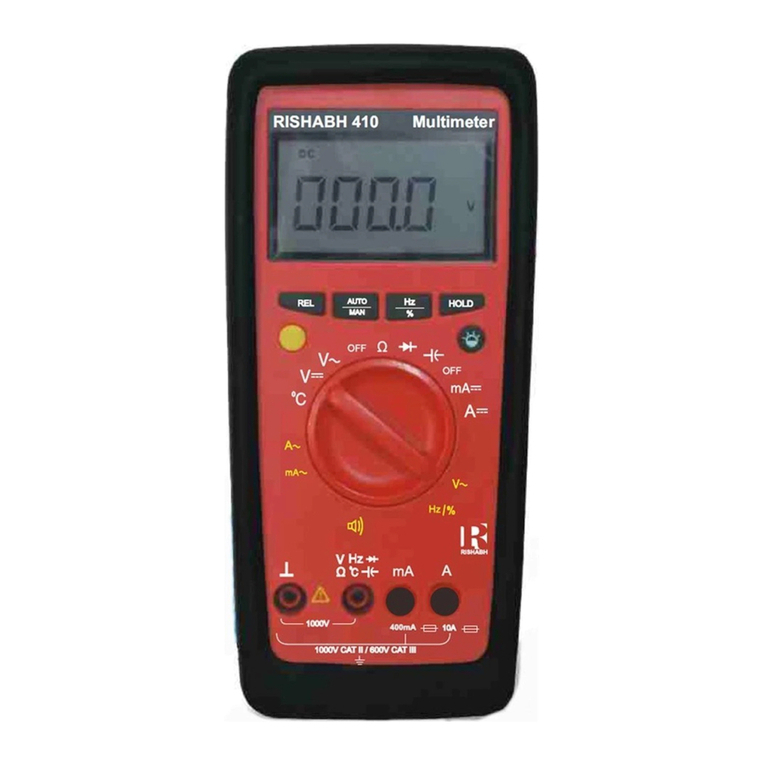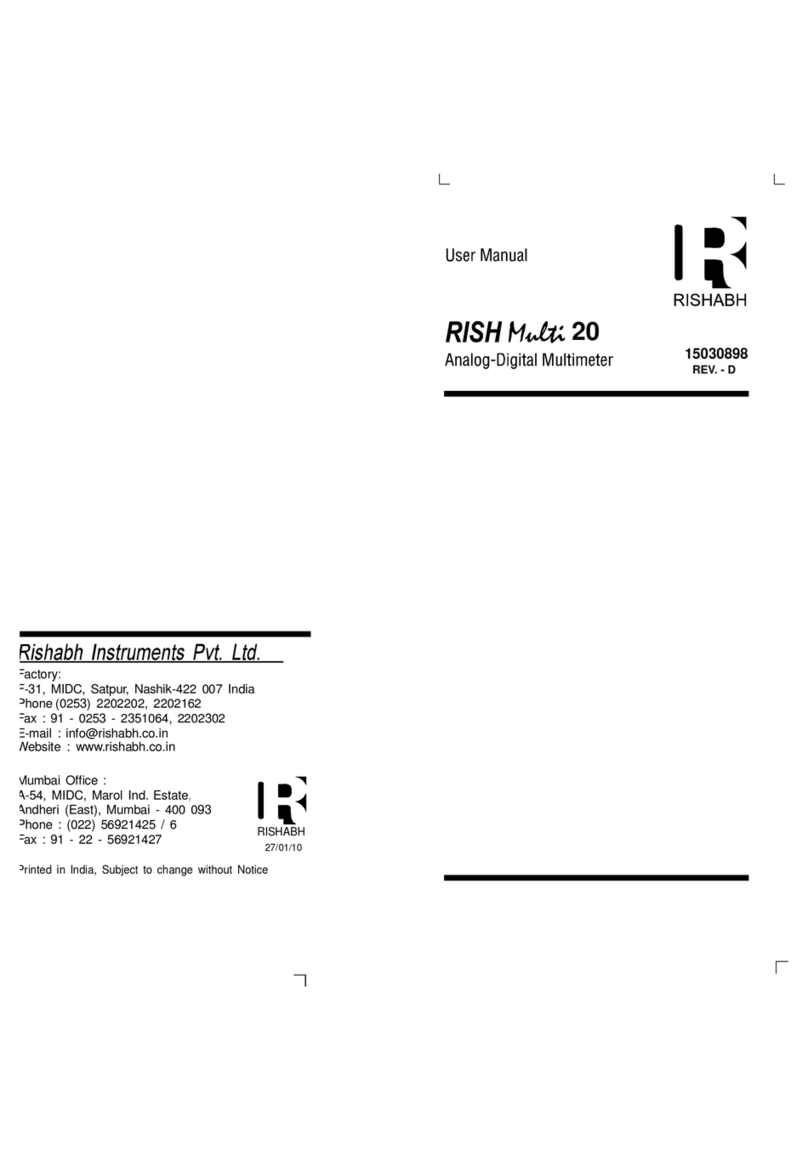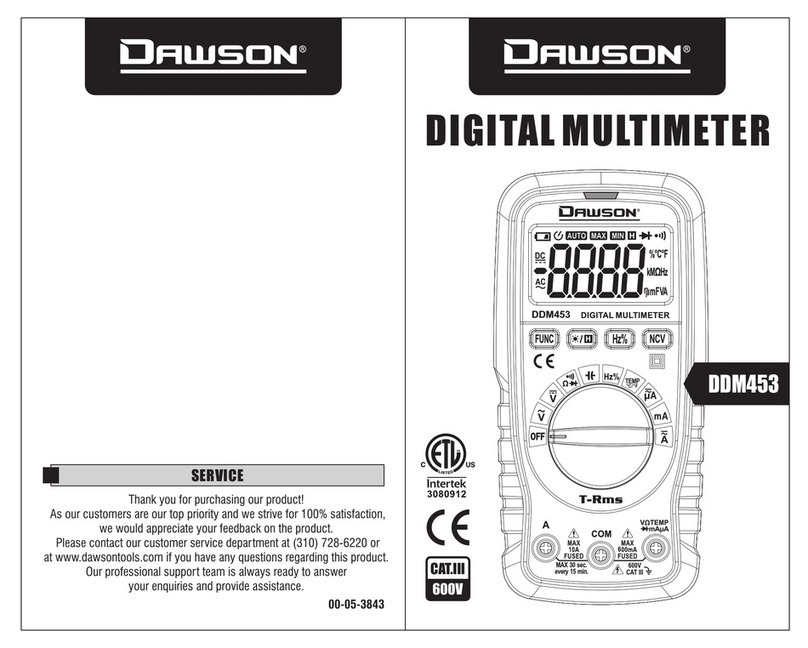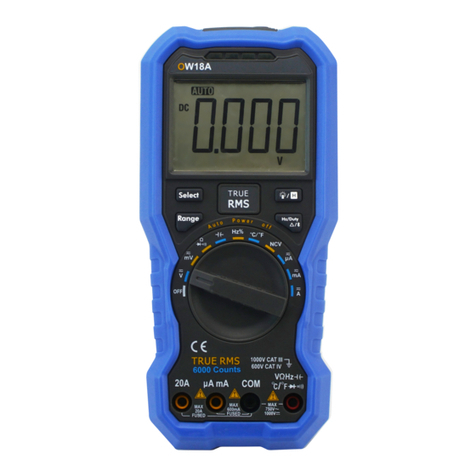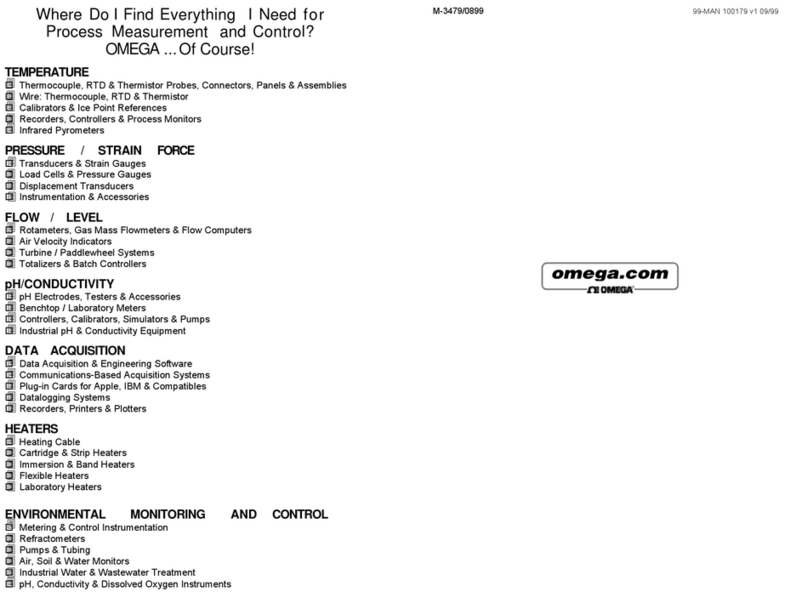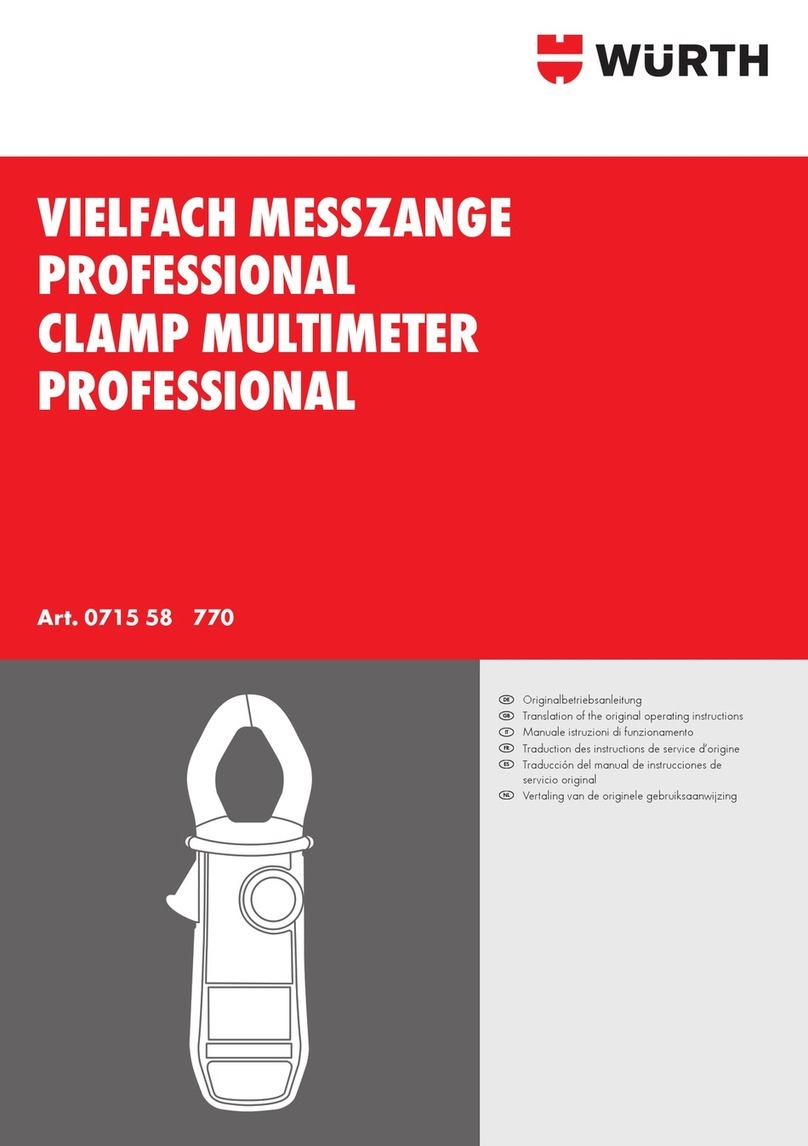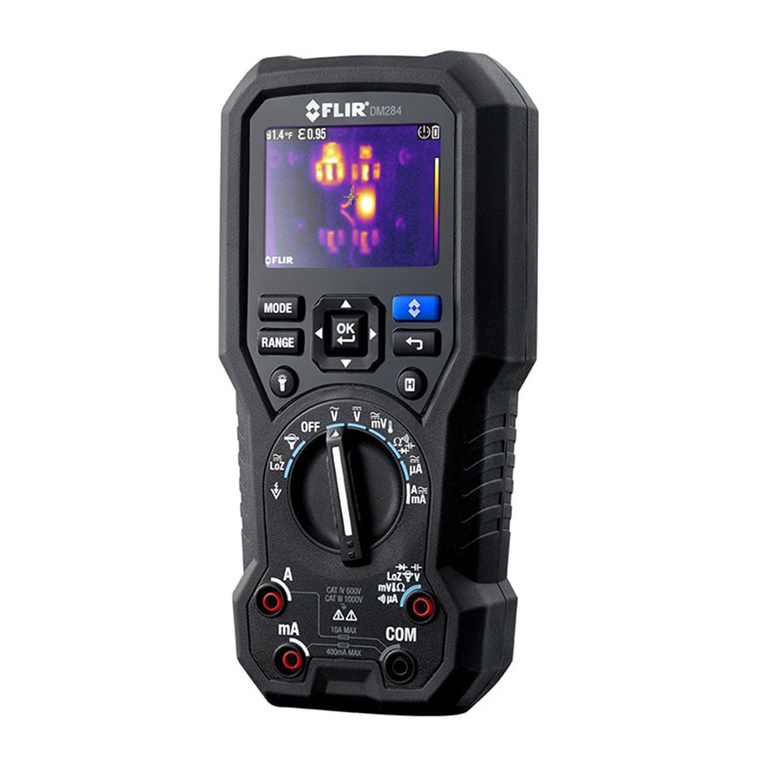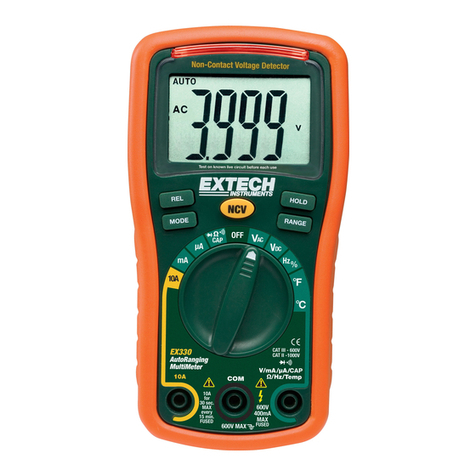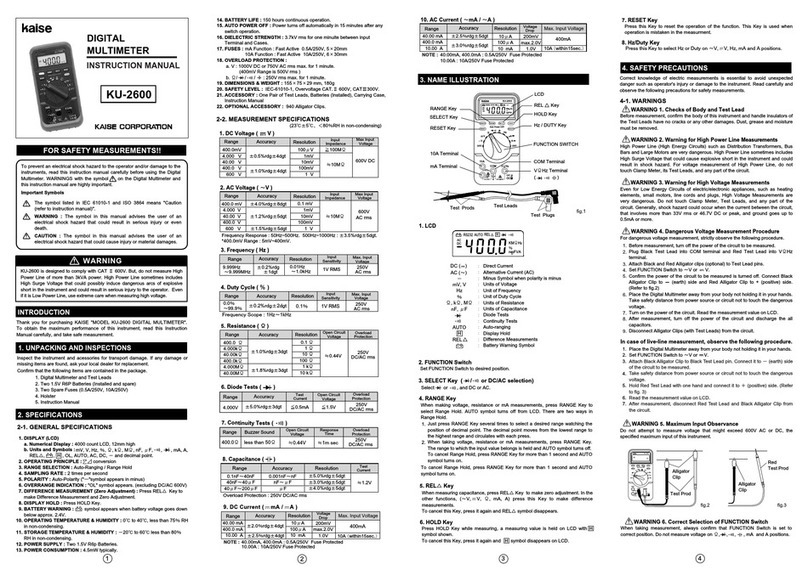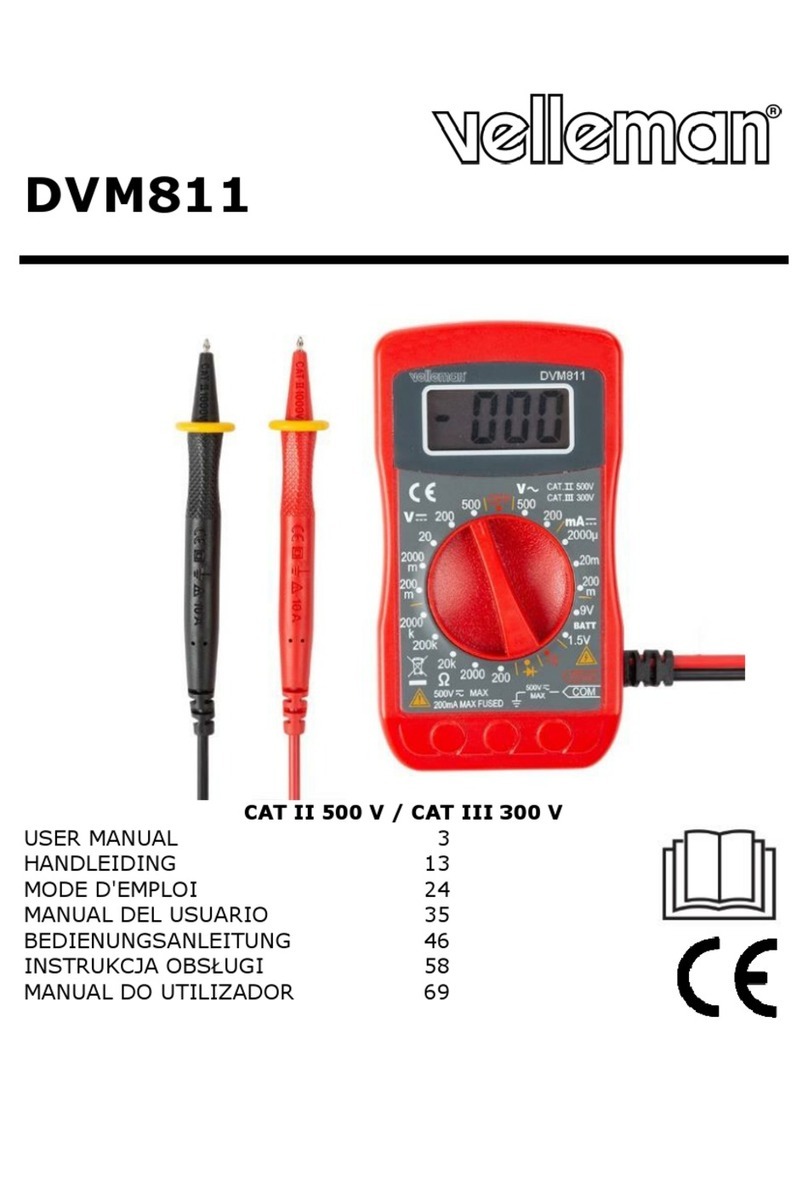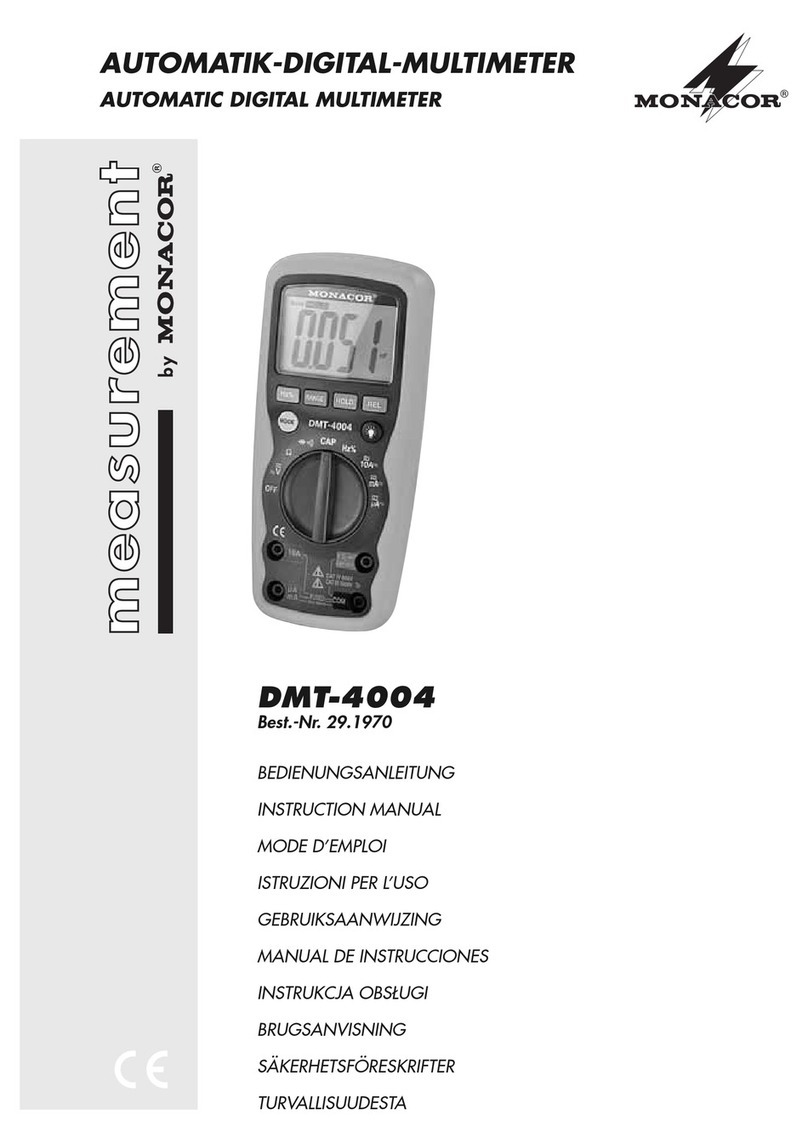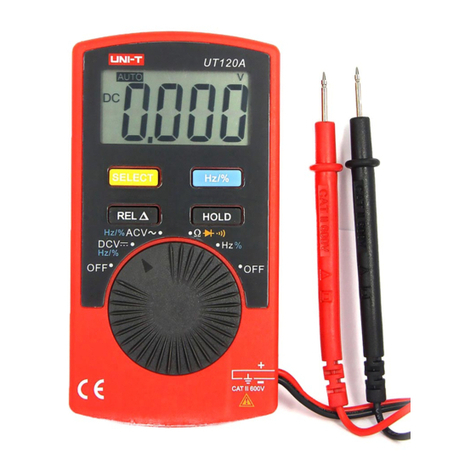Rishabh RISHMax 10 User manual

1000 V
fused
OFF ?F
Hz/%
V~
0C
F
0C
OFF
?
A
mA
FUNC AUTO/MAN REL HOLD/ON
0C
V~
V
A~
mA~
RISHABH INSTRUMENTS 2RISHABH INSTRUMENTS 3
RISH Max 10 Operating Elements
1 Terminal Sockets
2 LCD Display
3 Data HOLD/ ON Pushbutton
4 Pushbutton for Relative value
5 Function Selector Switch for ON/OFF
and Measurement Function Selection
6 Pushbutton for Automatic or Manual
range selection
7 Multifunction Pushbutton ( yellow key)
RISH Max 10 Display
1 Digital Display with Indication of Decimal Point and
Polarity
2 Low Battery Display
3 REL, HOLD, Display
4 Continuity Test Display : Buzzer Indication
5 Diode Measurement Display
6 Display for Unit of Measured Quantity
7 Display for Automatic Measuring Range Selection
8 Display of Selected Current / voltage Type
30893
User's Manual
Digital Multimeters
DMAN-00IM-0233_Rev B_27.04.2020

You have selected an instrument which provides you with a
high level of safety.
The RISH Max 10 digital multimeter is manufactured
in complaince with safety regulations. In case of incorrect
use or careless handling, the safety of both user and
multimeter is not assured.
To maintain the safe and proper condition of the meters
and to ensure their safe operation, it is absolutely neces-
sary to carefully and completely read these operating
instructions before using any meter. These instructions
must be followed in all respects.
Observe the following safety precautions :
* The meter must only be operated by persons who under-
stand the danger of shock hazards and know how to apply
safety precautions. Shock hazards exist anywhere, where
voltages of more than 30 V (TRMS) may occur.
* Do not work alone in shock hazardous environment while
carrying out measurement
* The maximum allowable voltage between any terminal
sockets (1) and earth is equal to 1000 V. Voltages of
greater than 500 V may only be applied to sockets " ", and
"V" with the selector switch in the voltage measurement
position (selector switch in "V" position).
* Take in to account that unexpected voltages can occur at
devices under test (e.g. defective devices). For example,
capacitors can be dangerously charged.
RISHABH INSTRUMENTS 4RISHABH INSTRUMENTS 5RISHABH INSTRUMENTS
1 Safety Features and Precautions
1. Safety Features and Precautions ...................
2. Initial Start-up ...................................................
3. Selecting Measuring Functions & Ranges ....
3.1 Measuring Function Selection............................
3.2 Automatic Measuring Range Selection..............
3.3 Manual Measuring Range Selection..................
4. Liquid Crystal Display ....................................
4.1 Digital Display ...................................................
5. Buzzer ..............................................................
6. Measurement Value Storage “HOLD”............
7. REL - Relative value measurement ...............
8. Voltage Measurement .....................................
9. Current Measurement ....................................
9.1 AC Measurement with (Clip-on) C.T. ................
10. Diode Testing & Continuity Measurement ....
10.1 Diode Testing ....................................................
10.2 Continuity Testing .............................................
11. Resistance Measurement ...............................
12. Capacitance Measurement ............................
13. Frequency & Duty cycle Measurement ........
13.1 Frequency Measurement .................................
13.2 Duty Cycle Measurement .................................
14. Temperature Measurement ............................
15. Specifications .................................................
16. Maintenance ....................................................
16.1 Battery ..............................................................
16.2 Fuses ................................................................
5
8
9
9
9
9
11
11
11
11
12
12
13
15
16
16
17
17
18
20
20
20
21
22
31
31
32
6
* Verify that the test leads are in good condition, e.g. no
cracked insulation, no open circuits in the leads or
connectors.
* This meter must not be used for measurements on circuits
with corona discharge (high-voltage).
* Be particularly careful when measurements are made in HF
electrical circuits. Dangerous composite voltages may be
present.
* Measurements under moist ambient conditions are not
permitted.
* Do not exceed the permissible overload limits of the
measuring ranges. Limit values can be found in the table
"Measuring Ranges" in chapter 15 "Specifications".
* All current ranges are equipped with fuses. The maximum
allowable voltage for the measuring current circuit
(=nominal voltage of the fuse) is equal to 600 V~.
* The instrument may only be used in power installations
when the electrical circuit is protected with a 20 A fuse
or circuit breaker, and the nominal voltage of the installation
does not exceed 600V(CAT III) and 1000V (CAT II).
CE
EU conformity mark.
Continuous, doubled or reinforced insulation.

Repair, Parts Replacement and Calibration
After opening the meter, live parts may be exposed. There-
fore, the meter must be disconnected from the measuring
circuit prior to opening its case for repair, replacement of parts
of calibration. If repair or calibration cannot be avoided unless
the meter is open and live, this work must be performed by a
qualified person who understands the danger involved.
Faults and extraordinary Stress
When it must be assumed that the safe operation is no longer
possible, take the meter out of service and secure it against
accidential use.
It is assumed that Safe operation is no longer possible,
* when the meter shows oblivious sign of damage,
CAT Definition
I
II
III
IV
The instruments used for measurement in electrical systems, those not
directly connected to the mains system: e.g. telecommunication equipments,
battery operated devices or batteries etc
This category instruments cover the local level of circuits for fixed or non-
fixed power devices: e.g. Lighting equipments, appliances and 120 V/240V
equipment inside house, offices or laboratories...
This category instruments can withstand transients found on distribution
circuits, feeders, lighting systems in large buildings..
This category instruments are designed for testing on the primary supply
source, which includes 120V/240 V overhead or underground lines. Also
electricity meters, mains terminal etc
Measuring categories and their Meaning per IEC 61010-1
The measurement category and relevant maximum rated
voltage (e.g. 600V CAT II) which are shown on the
instrument casing apply to your measuring instrument.
RISHABH INSTRUMENTS 78
Note !
Electrical discharge and high frequency interference
can cause incorrect displays, and may block
the measuring sequence. To reset, switch the
meter off, and then back on. If this procedure is
unsuccessful, briefly disconnect the battery from
the contact terminals.
Attention !
Before opening, disconnect the meter from the
measuring circuit and observe chapter 16,
page 28!
* when the meter no longer functions correctly,
* after a prolonged storage under adverse conditions,
* due to severe stress due to transportation.
2 Initial Start-Up
Battery
Fit the meter with battery (batteries) provided along with the
meter
please see chapter 16.1, page 28, before initial start-up of
your instrument, or after a lengthy period of storage.
Switching the Meter ON
Turn the Function selector switch from the OFF position to the
desired measuring function.
All of the segments of LCD are activated briefly.
A drawing of the LCD can be found on page 2.
9
Automatic turn-OFF
15 minutes, if no keys or the selector switch have been
activated during this time.
Switching the Meter back ON
Activate the HOLD/ON key.
Switching the Meter OFF
Turn the selector switch to the OFF position.
3 Selecting Measuring Functions and Ranges
3.1 Measuring Function Selection
The desired measuring function is selected with the Function
selector switch (blue or yellow printing). In order to select the
function printed in yellow half circle, the yellow multifunction
key must also be pressed. If the multifunction key is pressed
again, the function printed in blue half circle is reactivated.
Your meter switches itself OFF automatically after
3.2 Automatic Measuring Range Selection
These multimeters features autoranging for all measuring
ranges except for the ranges 400 mV ~ and 10 A. Automatic
selection is functional as soon as the meter is switched ON.
According to the measured quantity applied, the meter auto-
matically selects the measuring range which gives the best
resolution.
3.3 Manual Measuring Range Selection
You can switch OFF autoranging, select and fix the ranges
manually according to the table given on page 10.
First select the desired measuring function with the
function selector switch and, if appropriate, the
multifunction key.
Briefly activate the AUTO/MAN key.
RISHABH INSTRUMENTS RISHABH INSTRUMENTS

Note : 0
For Temperature ( C), Frequency (Hz), Duty cycle (%)
and Capacitance (F) measuring range is always Auto.
No manual range selection is possible.
10
AC
Manual mode is switched OFF if you press and hold the
AUTO/MAN key until you hear a second acoustic signal,
and the display switches to AUTO.
When switching back to automatic operation in the
400 mV~ range occurs, the 4 V ~ range is activated.
600
600
CAT III
CAT II
RISHABH INSTRUMENTS 11
5 Buzzer
The following steps are acknowledged by an sound signal :
* New measurement function selection
* Activation or deactivation of the following functions :
AUTO/MAN, REL or HOLD
* When measuring current, AC/DC mA > 400.0 mA,
AC/DC A > 10 A, the buzzer will keep sounding as
the overload warning.
* Approximate 1 minute before the meter is auto power off,
the buzzer will raise constantly 5 sounds to warning.
Before the meter is power off, the buzzer will raise one long
sound to warn the user
.
6 Measurement Value Storage "HOLD"
By pressing the HOLD/ON key, the currently displayed mea-
surement value can be "held", and "HOLD" is simultaneously
displayed on the LCD.
The Hold display is switched OFF if :
* the Hold key is reactivated
* the function selector switch is operated
* the yellow multi function key is activated for a change of
function, e.g. AC ----> DC.
4 Liquid Crystal Display
4.1 Digital Display
The digital display shows the measurement value, decimal
point and sign. The selected measuring unit and function are
displayed. When measuring DC quantities minus sign
appears in front of the digits, if the positive pole of the
measurement magnitude is applied to the " " input.
"OL" appears if the measuring range upper limit is
exceeded.
The digital display is updated thrice per second for V, A, W,
Capacitance, Frequency & Duty cycle measurements.
RISHABH INSTRUMENTS 12
Make certain that the current ranges ("mA" or "A")
are deactivated and that the measurement cables
are connected to the correct terminals, "V and ",
before connecting your multimeter for the measure-
ment of voltage! If the fuse tripping limit values are
exceeded due to operator error, both the operator
and the instrument are in danger! Observe the volt-
are limit values as printed on the meter !
Connect the measurement cable as shown. Terminal " "
should be grounded, and the second measuring cable with
a higher potential connected to Terminal "V".
The measuring range 400 mV ~ can only be
selected manually with the "AUTO/MAN" key!
Select the respective voltage type which corresponds to the
measuring value by briefly pressing the yellow multifunction
key. Each activation of the key causes alternate switching
between AC and DC, as well as acknowledgment by means
* REL key is activated.
* AUTO/MAN key is activated
7 REL - Relative value measurement
REL key is the key to measure relative value & it acts in
activation. All functions can be used for Relative value
Measurement except Hz / duty, diode & continuity function.
8 Voltage Measurement
By pressing the HOLD/ON key, the currentl
RISHABH INSTRUMENTS

13
a) Select function A with the function selector switch for cur-
rents > 400 mA, or function mA for currents < 400mA. When
measuring currents of an unknown magnitude, select the
highest measuring range first.
b) Select the function corresponding to the measured quantity
by briefly pressing the yellow multi-function key. Each time the
key is pressed, alternate switching takes place between AC
and DC, and change over is acknowledge by sound signal.
The symbols DC and ~ AC indicate the selected current
type in the LCD display.
After selection of this function with the selector switch,
the Current type DC is always activated.
c) Connect the measuring instrument in series to the load as
shown (without contact resistance).
First switch off the power supply to the measuring
circuit and/or to the load, and discharge any capac-
itors which might be present.
0C
IEC 61010-1
Voltage
fused
of an sound signal. The symbols DC and ~ AC indicate the
selected voltage type in the LCD display.
After selection of this function with the selector switch,
the voltage type DC is always activated.
14
* In the 400 mA measuring range an intermittent sound signal
warns you, if the measurement values has exceeded the
measuring range upper limit value.
* The 10 A current measuring range is protected with a 16 A/
600 V fuse. [ The breaking capacity of the fuse is equal to 50 kA
at nominal voltage of 600V with resistive load -- CAT III. ]
* If a fuse blows, eliminate the cause of the overload before
placing the meter back into operation!
* Fuse replacement is described in chapter 16.2, page 32.
0C
IEC 61010-1
Voltage
Fused
Notes on Current Measurement :
* The meter must be used only in power systems, when the
current circuit is protected with a 20 A fuse or circuit
breaker, and the nominal voltage of the system does not
exceed 600 V.
* Make the measuring circuit connections mechanically
strong and secure, so that they do not accidently open. The
conductor cross sections and connection points should be
designed to avoid excessive heating.
* Current ranges up to 400 mA are protected with a FF1.6 A/
1000V fuse. [ The breaking capacity of the fuse is equal 50kA
at nominal voltage of 600V with resistive load – CAT III ].
~
~
15
If current transformers are operated with an open
circuit on the secondary side, e.g. due to defective
or disconnected leads, a blown fuse in the meter or
a wrong connection, dangerously high voltages can
occur at the connections. For this reason, verify
that the current circuit of the multimeter and sec-
ondary winding of transformer connected to the
multimeter form an intact circuit. Connect the trans-
former to the sockets and mA or A
0C
Some currents transformers include safety devices, which pre-
vent dangerous voltage increases at open electrical circuits.
The maximum allowable operating voltage at the primary con-
ductor is equal to the nominal voltage of the current trans-
former. When reading the measurement value, consider the
transformation ration of the transformer, as well as additional
display error.
9.1.2 Transformer Output mV/A.
Some transformers have a voltage output(designation: mV/A).
Consequently, the secondary connection must be connected
to and V.
IEC 61010-1
Voltage
fused
RISHABH INSTRUMENTS RISHABH INSTRUMENTS RISHABH INSTRUMENTS

16
0C
Conducting Direction and Short-Circuit
The measuring instrument displays the forward voltage in
volts. As long as the voltage drop does not exceed the maxi-
mum display value of 1.000 V, you can test several elements
connected in series.
Reverse Direction or Interruption
The measuring instrument displays a voltage of 'OL'
Resistors and semiconductor paths in parallel to
the diode distort the measurement results!
Voltage
fused
IEC 61010-1
10 Diode Testing & Continuity Measurement
10.1 Diode Testing
* Set the function selector switch to " ".
*Connect the device under test as shown.
Verify that the device under test is electrically dead.
External voltages would falsity the mesurement
results!
17
10.2 Continuity Testing
Verify that the device under test is electrically dead.
External voltages would falsify the measurement
results!
* Set the selector switch to " "
Press the yellow multifunction key to switch to the continuity
measuring range. Display of the symbol is activated.
The instrument generates a continuous sound signal at a
measured resistance of 0... approx. < 75 .
* Connect the Device Under Test as shown.
Verify that the device under test is electrically dead.
External voltages would falsify the measurement
results!
* Set the selector switch to " ".
* Connect the Device Under Test as shown.
11 Resistance Measurement
0C
IEC 61010-1
Voltage
fused
0C
Voltage
fused
IEC 61010-1
Zero Adjustment (Relative mode)
In the measurement of resistance the inherent error of the
meter and the resistance of leads can be eliminated by zero
adjustment.
- Short the leads connected to meter
- Press REL key
The instrument acknowledges zero adjustment with a sound
signal & value close to 00 & REL are displayed on LCD.
18
Set the function selector switch to "F"
Connect the (discharged!) device under test socket " " and
"F" with measurement leads. Polarized capacitors must be
connected to the " " socket at the " -- " pole.
Be absolutely certain that the device under test is
electrically dead. External voltages would falsify the
measurement results!
The resistance measured at the moment the REL key is
pressed serves as a reference value. This value is then
automatically subtracted from all measured value.
Deleting Zero Adjustment
Short the leads connected to meter and then press REL key.
or Activate the function selector switch.
or Switch the Multimeter off.
RISHABH INSTRUMENTS RISHABH INSTRUMENTS RISHABH INSTRUMENTS

19
Zero Adjustment (relative mode)
For the measurement of small capacitance values in the 5 nF
and 50 nF ranges, the inherent error of the meter and the
capacitance of the leads can be eliminated by zero adjust-
ment.
- Connect the leads to the meter without without Device under test
- Briefly Press the REL key.
The instrument acknowledges zero adjustment with an
sound signal, and a value close to "00.00" and REL are dis-
played at the LCD. The capacitance measured at the
moment the key is activated serves as a reference value.
This value is then automatically subtracted from all mea-
sured values.
Deleting Zero adjustment
Press REL key
clearance is acknowledged by buzzer sound.
or Activate the function selector switch
or Switch the multimeter off.
0C
Resistors and semiconductor paths in parallel to
the capacitor falsify the measurement results!
To measure small value capacitors please use
short measurement cables!
If is displayed the measured values are not valid.
Voltage
fused
IEC 61010-1
20
Duty cycle (%) =
pulse duration
cycle duration X 100
13 Frequency & Duty Cycle Measurement
13.1 Frequency Measurement
a) Set the function selector switch to V~/Hz/% and press Yellow
multi-function key, as shown on page 21.
The frequency measurement mode is activated. "Hz" symbol
is displayed on the LCD. The digital display is expanded to
9999 digits. Only the auto mode is possible, no manual range
is possible.
b) Connections are made the same way as for voltage
measurement.
c) The lowest measurable frequencies and the maximum
allowable voltages can be found in the chapter 15.
"Specifications".
13.2 Duty Cycle Measurement
a) With duty cycle measurement, we can determine the ratio
of pulse duration to cycle time of recurring square wave
signals. The duty cycle that is the percentage pulse duration
of signal is displayed on LCD i.e.
Note : The applied frequency must remain constant during
the duty cycle measurement.
b) Set the function selector switch to V~/Hz/% and press
yellow multi-function key twice as shown on page 21.
The duty cycle (%) mode is activated. "%" symbol is
displayed on LCD.
21
V~
V~
0C
K-type
sensor
0C
b) Connections are made the same way as for Voltage
measurement
c) Measuring range for duty cycle and maximum allowable
voltage can be found in chapter "Specification".
14 Temperature Measurement
The Multimeterallows you to measure temperature with K-type
0 0
thermocouple (NiCr-Ni) in the range 0 C to +1300 C.
0
Set the function selector switch to " C".
Connect the sensor as shown below.
Voltage
fused
IEC 61010-1
Voltage
fused
IIEC 61010-1
RISHABH INSTRUMENTS RISHABH INSTRUMENTS RISHABH INSTRUMENTS

15. Specifications ( CAT II )
Meas.
Function
Measuring
Function Resolution
Input Impedance
400.0mV
4.000V
40.00V
400.0V
1000V
400.0mV
4.000V
40.00V
400.0V
1000V
100mV
1mV
10mV
100mV
1V
100mV
1mV
10mV
100mV
1V
40.00mA
400.0mA
1)
10.00A
40.00mA
400.0mA
1)
10.00A
10mA
100mA
10mA
10mA
100mA
10mA
400.0W
4.000kW
40.00kW
400.0kW
4.000MW
40.00MW
400.0W
1.000V
5.000nF
50.00nF
500.0nF
5.000mF
50.00mF
200.0mF
100mW
1W
10W
100W
1kW
10kW
100mW
1mV
1pF
10pF
100pF
1nF
10nF
100nF
10.000Hz
100.00Hz
1.0000kHz
10.000kHz
100.00kHz
500.0kHz
0.001Hz
0.01Hz
0.1Hz
1Hz
10Hz
100Hz
2.0...98.0% 0.1%
V(AC) / V(DC)
>20MW
11MW
10MW
10MW
10MW
11MW
11MW
10MW
10MW
10MW
Approx. Voltage drop
at max. meas. current
450mV
4.2V
750mV
450mV
4.2V
750mV
Open-circuit voltage
approx 0.45V
approx 1V
10Hz
10Hz
10Hz
10Hz
10Hz
10Hz
fmin
F
Hz
%
V
V
A
A
2)
Sensor
0
0...+1300 C
0
C
0
1 C
NiCr-Ni
K-type
1) max. 10 A / 30 min. 12 A / 5 min. 16 A / 30 Sec
2) Indication for frequency measurement expanded to 9999 D
22 23
40.00mA
400.0mA
4)
10.00A
40.00mA
400.0mA
4)
10.00A
400.0W
4.000kW
40.00kW
400.0kW
4.000MW
40.00MW
400.0W
1.000V
5.000nF
50.00nF
500.0nF
5.000mF
50.00mF
200.0mF
10.000Hz
100.00Hz
1.0000kHz
10.000kHz
100.00kHz
500.0kHz
2.0...98.0%
0
0...+1300 C
0.8+2
1.5+5
1+5
2+5
0.8+5
0.8+2
1+5
2+5
Acoustic signal for
0...<75W(approx)
2+10
2)
3+40
2)
2+10
2)
0.5+3
2)
1+2
2)
1.5+2
3)
5+10
0.2+2
10Hz...1kHz : +5D
1kHz...10kHz : +5D/kHz
2+3
Continuous
Continuous
480mA
4)
480mA
4) 4)
4)
500V
DC/AC
rms 10 min
500V
DC/AC
rms
Continuous
10 min
10 min
<1kHz : 1000V
<10kHz : 400V
<500kHz : 40V
except 400mV
500V DC/AC
rms
Measuring
Function
400.0mV
4.000V
40.00V
400.0V
1000V
400.0mV
4.000V
40.00V
400.0V
1000V
Digital display inherent
deviation at
reference conditions
+ (...% of rdg + ...digits)
0.75+2
0.5+2
1.5+5
1+5
1+10
1)
Overload capacity
Overload value Overload
duration
1050V(DC)
1050V(AC)
rms Continuous
Continuous
Meas.
Function
F
5)
Hz
%
0
C
V
V
A
A
0 0
1) At 0 C... + 40 C
2) With zero adjustmet “REL”.
3) Time required for measurement approximately 60 seconds.
4) max. 10 A/30 min 12 A/5 min 16 A/30 s
5) Indication of the frequency measurement expanded to up to 9999 digits
Specifications ( CAT II )
Specifications ( CAT II )I
Meas.
Function
Measuring
Function Resolution
Input Impedance
400.0mV
4.000V
40.00V
400.0V
600V
400.0mV
4.000V
40.00V
400.0V
600V
100mV
1mV
10mV
100mV
1V
100mV
1mV
10mV
100mV
1V
40.00mA
400.0mA
1)
10.00A
40.00mA
400.0mA
1)
10.00A
10mA
100mA
10mA
10mA
100mA
10mA
400.0W
4.000kW
40.00kW
400.0kW
4.000MW
40.00MW
400.0W
1.000V
5.000nF
50.00nF
500.0nF
5.000mF
50.00mF
200.0mF
100mW
1W
10W
100W
1kW
10kW
100mW
1mV
1pF
10pF
100pF
1nF
10nF
100nF
10.000Hz
100.00Hz
1.0000kHz
10.000kHz
100.00kHz
500.0kHz
0.001Hz
0.01Hz
0.1Hz
1Hz
10Hz
100Hz
2.0...98.0% 0.1%
V(AC) / V(DC)
>20MW
11MW
10MW
10MW
10MW
11MW
11MW
10MW
10MW
10MW
Approx. Voltage drop
at max. meas. current
450mV
4.2V
750mV
450mV
4.2V
750mV
Open-circuit voltage
approx 0.45V
approx 1V
10Hz
10Hz
10Hz
10Hz
10Hz
10Hz
fmin
F
Hz
%
V
V
A
A
2)
Sensor
0
0...+1300 C
0
C
0
1 C
NiCr-Ni
K-type
1) max. 10 A / 30 min. 12 A / 5 min. 16 A / 30 Sec
2) Indication for frequency measurement expanded to 9999 D
24
RISHABH INSTRUMENTS RISHABH INSTRUMENTS RISHABH INSTRUMENTS

25
40.00mA
400.0mA
4)
10.00A
40.00mA
400.0mA
4)
10.00A
400.0W
4.000kW
40.00kW
400.0kW
4.000MW
40.00MW
400.0W
1.000V
5.000nF
50.00nF
500.0nF
5.000mF
50.00mF
200.0mF
10.000Hz
100.00Hz
1.0000kHz
10.000kHz
100.00kHz
500.0kHz
2.0...98.0%
0
0...+1300 C
0.8+2
1.5+5
1+5
2+5
0.8+5
0.8+2
1+5
2+5
Acoustic signal for
0...<75W(approx)
2+10
2)
3+40
2)
2+10
2)
0.5+3
2)
1+2
2)
1.5+2
3)
5+10
0.2+2
10Hz...1kHz : +5D
1kHz...10kHz : +5D/kHz
2+3
Continuous
Continuous
480mA
4)
480mA
4) 4)
4)
600V
DC/AC
rms 5 min
600V
DC/AC
rms
Continuous
5 min
5 min
600V DC/AC
rms
Measuring
Function
400.0mV
4.000V
40.00V
400.0V
600V
400.0mV
4.000V
40.00V
400.0V
600V
Digital display inherent
deviation at
reference conditions
+ (...% of rdg + ...digits)
0.75+2
0.5+2
1.5+5
1+5
1+10
1)
Overload capacity
Overload value Overload
duration
600V(DC)
600V(AC)
rms Continuous
Continuous
Meas.
Function
F
5)
Hz
%
0
C
V
V
A
A
0 0
1) At 0 C... + 40 C
2) With zero adjustmet “REL”.
3) Time required for measurement approximately 60 seconds.
4) max. 10 A/30 min 12 A/5 min 16 A/30 s
5) Indication of the frequency measurement expanded to up to 9999 digits
600V DC/AC
rms
Specifications ( CAT I )II
0
0
0
0
0
26
27
Influence quality and Effects ( CAT II )
RISHABH INSTRUMENTS RISHABH INSTRUMENTS RISHABH INSTRUMENTS

28
600
600
600
600
600
Influence quality and Effects ( CAT III )
29
j
j
~
~
~
30
RISHABH INSTRUMENTS RISHABH INSTRUMENTS RISHABH INSTRUMENTS
1000 V;

31
16 Maintenance
Attention :
Disconnect the instrument from the measuring circuit before
opening the instrument to replace the battery or the fuse !
16.1 Battery
Before initial start-up, or after storage of your instrument,
make sure that no leakage has occurred at the instrument
battery. Repeat this inspection at regular intervals.
If battery leakage has occurred, electrolyte from the battery
must be carefully and completely removed and a new battery
must be installed, before the instrument can be placed back
into operation.
If the " " symbol appears in the LCD display, you should
change the battery as soon as possible. You can continue to
take measurements, but reduced measuring accuracy may
result.
Replacing the Battery(ies)
The housing base must be removed from the instrument in
order to replace the battery(ies).
Press the tab located beneath connector jacks with a test
probe, a banana plug or a similar object in the direction
indicated by the arrow as shown on the housing base, and
remove the base.
Remove the battery from the battery compartment.
Insert two new 1.5 V mignon cells in accordance with the
polarity symbols in the battery compartment.
Place both battery cables between the cells before closing
the housing in order to prevent pinching of the cables.
32
Be absolutely certain that only the specified fuses
as above are used. The use of fuse with different
specifications may place the operator, the system
& measuring instrument in danger. The use of
repaired fuses or short-circuting of the fuse holder
is prohibited.
Replace the housing base and press until it snaps audibly
into place.
Dispose of the dead battery in an environmentally sound
fashion.
16.2 Fuses
The 16 A fuse interrupts the 10 A current measuring range,
and the 1.6 A fuse the mA current measuring ranges. All
other measuring ranges continue to function.
If a fuse blows, eliminate the cause of the overload before
placing the instrument back into operation!
Replacement of Fuses
Open the instrument as described under battery replacement.
Remove the defective fuse with the help of, for example, a
test probe, and replace it with a new fuse.
Make certain that the new fuse makes good contact.
The following fuses may be used :
* for current measuring ranges up to 4mm mA :
type FF 1.6 A / 1000 V~ ; 6.3 mm x 32 mm
* for the 10 A measuring range :
type FF 16 A / 600 V~ ; 6.3 mm x 32 mm
1) Multimeter
2) Cable set
3) Safety Cover
4) Belt
5) Battery
6) User Manual
7) Warranty Card
8) Test Certificate
*
*
RISHABH INSTRUMENTS RISHABH INSTRUMENTS RISHABH INSTRUMENTS
This manual suits for next models
1
Table of contents
Other Rishabh Multimeter manuals

